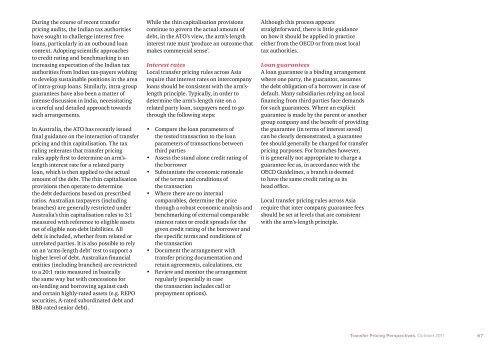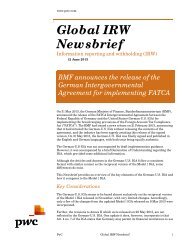Transfer pricing perspectives: Winds of Change - PwC
Transfer pricing perspectives: Winds of Change - PwC
Transfer pricing perspectives: Winds of Change - PwC
You also want an ePaper? Increase the reach of your titles
YUMPU automatically turns print PDFs into web optimized ePapers that Google loves.
During the course <strong>of</strong> recent transfer<strong>pricing</strong> audits, the Indian tax authoritieshave sought to challenge interest freeloans, particularly in an outbound loancontext. Adopting scientific approachesto credit rating and benchmarking is anincreasing expectation <strong>of</strong> the Indian taxauthorities from Indian tax-payers wishingto develop sustainable positions in the area<strong>of</strong> intra‐group loans. Similarly, intra‐groupguarantees have also been a matter <strong>of</strong>intense discussion in India, necessitatinga careful and detailed approach towardssuch arrangements.In Australia, the ATO has recently issuedfinal guidance on the interaction <strong>of</strong> transfer<strong>pricing</strong> and thin capitalisation. The taxruling reiterates that transfer <strong>pricing</strong>rules apply first to determine an arm’slengthinterest rate for a related partyloan, which is then applied to the actualamount <strong>of</strong> the debt. The thin capitalisationprovisions then operate to determinethe debt deductions based on prescribedratios. Australian taxpayers (includingbranches) are generally restricted underAustralia’s thin capitalisation rules to 3:1measured with reference to eligible assetsnet <strong>of</strong> eligible non‐debt liabilities. Alldebt is included, whether from related orunrelated parties. It is also possible to relyon an ‘arms‐length debt’ test to support ahigher level <strong>of</strong> debt. Australian financialentities (including branches) are restrictedto a 20:1 ratio measured in basicallythe same way but with concessions foron‐lending and borrowing against cashand certain highly‐rated assets (e.g. REPOsecurities, A‐rated subordinated debt andBBB-rated senior debt).While the thin capitalisation provisionscontinue to govern the actual amount <strong>of</strong>debt, in the ATO’s view, the arm’s-lengthinterest rate must ‘produce an outcome thatmakes commercial sense’.Interest ratesLocal transfer <strong>pricing</strong> rules across Asiarequire that interest rates on intercompanyloans should be consistent with the arm’slengthprinciple. Typically, in order todetermine the arm’s-length rate on arelated party loan, taxpayers need to gothrough the following steps:• Compare the loan parameters <strong>of</strong>the tested transaction to the loanparameters <strong>of</strong> transactions betweenthird parties• Assess the stand alone credit rating <strong>of</strong>the borrower• Substantiate the economic rationale<strong>of</strong> the terms and conditions <strong>of</strong>the transaction• Where there are no internalcomparables, determine the pricethrough a robust economic analysis andbenchmarking <strong>of</strong> external comparableinterest rates or credit spreads for thegiven credit rating <strong>of</strong> the borrower andthe specific terms and conditions <strong>of</strong>the transaction• Document the arrangement withtransfer <strong>pricing</strong> documentation andretain agreements, calculations, etc• Review and monitor the arrangementregularly (especially in casethe transaction includes call orprepayment options).Although this process appearsstraightforward, there is little guidanceon how it should be applied in practiceeither from the OECD or from most localtax authorities.Loan guaranteesA loan guarantee is a binding arrangementwhere one party, the guarantor, assumesthe debt obligation <strong>of</strong> a borrower in case <strong>of</strong>default. Many subsidiaries relying on localfinancing from third parties face demandsfor such guarantees. Where an explicitguarantee is made by the parent or anothergroup company and the benefit <strong>of</strong> providingthe guarantee (in terms <strong>of</strong> interest saved)can be clearly demonstrated, a guaranteefee should generally be charged for transfer<strong>pricing</strong> purposes. For branches however,it is generally not appropriate to charge aguarantee fee as, in accordance with theOECD Guidelines, a branch is deemedto have the same credit rating as itshead <strong>of</strong>fice.Local transfer <strong>pricing</strong> rules across Asiarequire that inter company guarantee feesshould be set at levels that are consistentwith the arm’s-length principle.<strong>Transfer</strong> Pricing Perspectives. October 201167
















